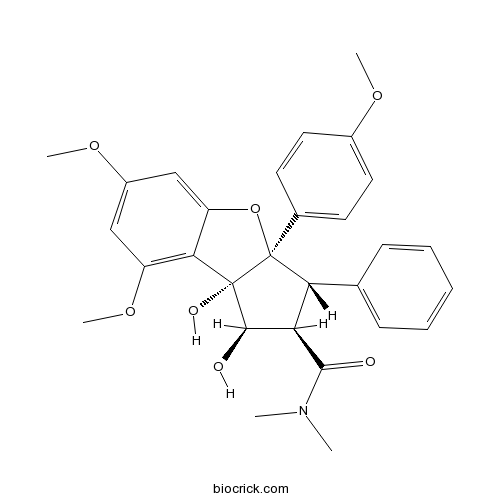An organic heterotricyclic compound that is 2,3,3a,8b-tetrahydro-1H-benzo[b]cyclopenta[d]furan substituted by hydroxy groups at positions 1 and 8b, methoxy groups at positions 6 and 8, a 4-methoxyphenyl group at position 3a, a phenyl group at position 3 and a N,N-dimethylcarbamoyl group at position 1. Isolated from Aglaia odorata and Aglaia duperreana, it exhibits antineoplastic activity.
InChI=1S/C29H31NO7/c1-30(2)27(32)23-24(17-9-7-6-8-10-17)29(18-11-13-19(34-3)14-12-18)28(33,26(23)31)25-21(36-5)15-20(35-4)16-22(25)37-29/h6-16,23-24,26,31,33H,1-5H3/t23-,24-,26-,28+,29+/m1/s1
Rocaglamide (Roc), derived from the traditional Chinese medicinal plants Aglaia, induces apoptosis through the intrinsic death pathway in various human leukemia cell lines and in acute lymphoblastic leukemia, chronic myeloid leukemia and acute myeloid leukemia cells freshly isolated from patients.[1]
Rocaglamides are potent natural anticancer products that inhibit proliferation of various cancer cells at nanomolar concentrations, these compounds prevent tumor growth and sensitize resistant cancer cells to apoptosis by blocking the MEK-ERK-eIF4 pathway, suggests that rocaglamides are a new type of anticancer agent and that they may serve as a small-molecular tool for studying PHB-mediated cellular processes.[2]
Rocaglamides can suppress the PMA-induced expression of NF-kappaB target genes and sensitize leukemic T cells to apoptosis induced by TNFalpha, cisplatin, and gamma-irradiation, suggests that rocaglamide derivatives could serve as lead structures in the development of anti-inflammatory and tumoricidal drugs.[3]
Rocaglamide and a XIAP inhibitor cooperatively sensitize TRAIL-mediated apoptosis in Hodgkin's lymphomas.[4]
English website: Rocaglamide
Japanese website: Rocaglamide
Chinese website: Rocaglamide
[1] Jia Y. Zhu †, Inna N. Lavrik †, Mahlknecht U, et al. Int J Cancer, 2007, 121(8):1839-46.
[2] Polier G, Neumann J, Thuaud F, et al. Chem Biol, 2012, 19(9):1093-104.
[3] Baumann B, Bohnenstengel F, Siegmund D, et al. J Biol Chem, 2002, 277(47):44791-800.
[4] Giaisi M, Köhler R, Fulda S, et al. Int J Cancer, 2012, 131(4):1003-8.
[5] Zhang J Y, Li N, Zhou Y, et al. Anal Methods, 2012, 4(10):3399-406.



